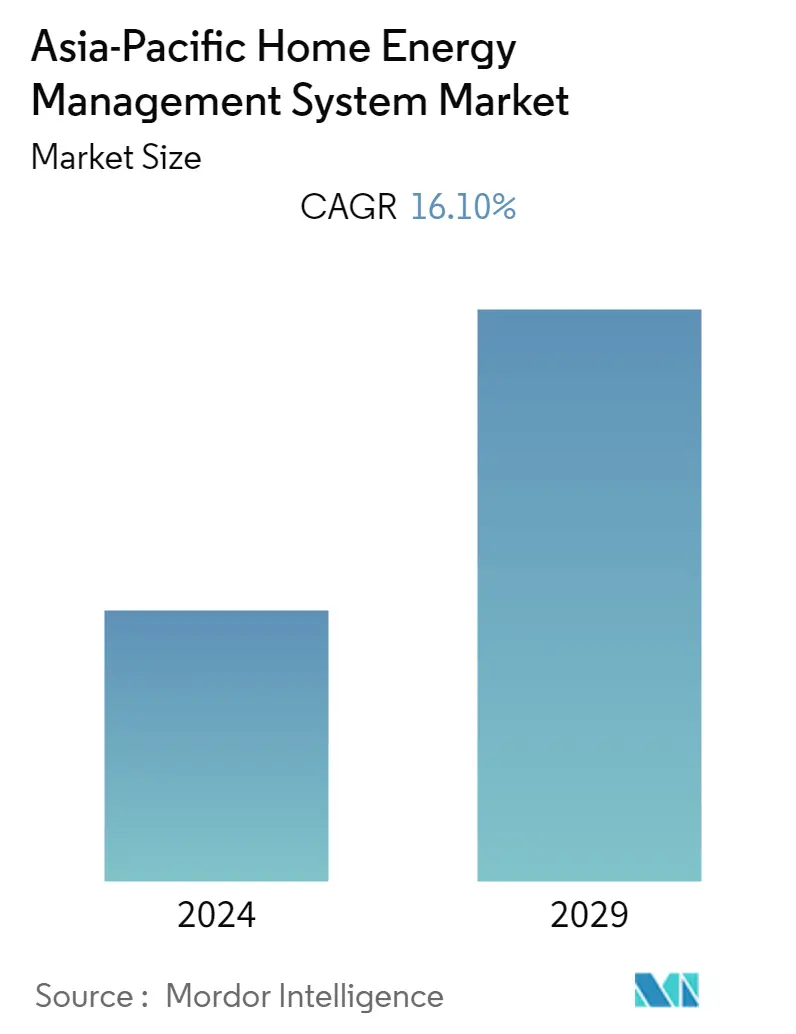Market Size of Asia-Pacific Home Energy Management System Industry

| Study Period | 2019 - 2029 |
| Base Year For Estimation | 2023 |
| Forecast Data Period | 2024 - 2029 |
| Historical Data Period | 2019 - 2022 |
| CAGR (2024 - 2029) | 16.10 % |
| Market Concentration | Medium |
Major Players
*Disclaimer: Major Players sorted in no particular order |
Asia-Pacific Home Energy Management System Market Analysis
The Asia-Pacific Home Energy Management System Market is expected to register a CAGR of 16.10% during the forecast period(2024-2029).
The Asia-Pacific home energy management system market is primarily growing due to rising awareness of energy management and rising investment in smart grids. According to IFSEC Global, China recently invested USD 75 billion in electricity grids.
- With rapid technological advancements, like network communication, bidirectional communication mediums, information infrastructures, energy conservation methodologies, and various techniques, home area networks (HANs) experienced a revolutionary change in numerous areas of power consumption domains, like energy saving at consumption premises and electricity usage patterns.
- For instance, in January 2022, Google launched Nest Hub's 2nd generation in the Indian market. The company claims to offer an improved audio experience with 50% more volume than the original hub and a third mic for better Google Assistant response. Featuring a 7-inch color display, this smart display doubles up as a digital photo frame.
- Furthermore, due to increasing concern about the efficient use of energy, there is an expanding focus on installing energy-saving devices in households. Energy management systems are cost-effective in all residential buildings, regardless of national energy prices, usage, or climatic factors. Thus, they are increasingly being adopted into homes.
- Various companies are innovating new solutions as part of their business expansion. For instance, in April 2022, Samsung Electronics partnered with international technology company ABB to expand Samsung SmartThings integration into more homes and buildings. Further, due to this collaboration, Samsung may strengthen its home IoT solution in the residential and commercial construction markets by combining smart home solutions with SmartThings for more advanced, economical, and energy-efficient solutions for monitoring and controlling homes and buildings.
- Furthermore, the hardware components of home energy management systems cost much more than the software and service components, which may further hamper the studied market's growth. In addition, for maintenance, the need for more skilled laborers across the region is expected to increase costs as most of them have to travel down to the service areas and resolve issues. However, the growing focus on remote maintenance may reduce the cost burden during the forecast.
- Since the novel COVID-19 was declared a pandemic, most firms and plants were closed or were under severe restrictions. On the other hand, energy consumption in homes increased drastically. However, power and energy consumption declined overall, mainly due to the break in manufacturing activity in China, India, and Japan. Nevertheless, relaxation of the restrictions was apparent in the months ahead. Given the government's initiatives to decrease energy consumption, the region is likely to create opportunities over the forecast period.
Asia-Pacific Home Energy Management System Industry Segmentation
A home energy management system is a technology-based platform comprising hardware and software that authorizes the user to monitor power usage and production and manually control and automate energy use within a household. The HEMS performs at the intersection of three different sectors within a home: home appliances, metering, and the communication network.
The Asia-Pacific home energy management system market is segmented by component (hardware, software, and services), product (lighting controls, self-monitoring systems, and services, programmable communicating thermostats, advanced central controllers, intelligent HVAC controllers), technology (ZigBee, Wi-Fi, Internet, Z-Wave, and other technologies), and country (China, India, Japan, South Korea, and the Rest of Asia-Pacific). The market sizes and forecasts are provided in terms of value in USD for all the segments.
| By Component | |
| Hardware | |
| Software | |
| Services |
| By Product | |
| Lighting Controls | |
| Self-Monitoring Systems and Services | |
| Programmable Communicating Thermostats | |
| Advanced Central Controllers | |
| Intelligent HVAC Controller |
| By Technology | |
| ZigBee | |
| Wi-Fi | |
| Internet | |
| Z-Wave | |
| Other Technologies |
| By Country | |
| China | |
| India | |
| Japan | |
| South Korea | |
| Rest of the Asia-Pacific |
Asia-Pacific Home Energy Management System Market Size Summary
The Asia-Pacific home energy management system market is experiencing significant growth, driven by increasing awareness of energy management and substantial investments in smart grid technologies. The region's diverse landscape, with countries like China and India leading in smart meter production, is fostering demand for these systems. Technological advancements in network communication and energy conservation methodologies are revolutionizing home area networks, enabling better energy-saving practices and optimized electricity usage patterns. The market is further bolstered by the rising adoption of energy-saving devices in households, as these systems prove to be cost-effective across various residential settings. Collaborations among major companies, such as Samsung Electronics and ABB, are enhancing the integration of smart home solutions, contributing to the market's expansion.
China stands out as a dominant player in the Asia-Pacific home energy management market, supported by its high penetration of solar PV and electric heating appliances. The country's substantial investments in grid digitization and infrastructure development are expected to drive market growth. Innovations in smart devices, such as the Xiaomi Mijia Smart Socket and BroadLink's FastCon BLE smart home solution, are further propelling the market. The semi-consolidated nature of the market sees international players like IBM, Honeywell, and Schneider Electric launching technologically advanced products and forming strategic collaborations to enhance their market presence. Government initiatives promoting renewable energy and efficient power grid solutions are also playing a crucial role in shaping the market's trajectory in the region.
Asia-Pacific Home Energy Management System Market Size - Table of Contents
-
1. MARKET INSIGHTS
-
1.1 Market Overview
-
1.2 Industry Attractiveness - Porter's Five Forces Analysis
-
1.2.1 Bargaining Power of Suppliers
-
1.2.2 Bargaining Power of Buyers
-
1.2.3 Threat of New Entrants
-
1.2.4 Threat of Substitutes
-
1.2.5 Intensity of Competitive Rivalry
-
-
1.3 Industry Value Chain Analysis
-
1.4 Assessment of Impact of COVID-19 on the Market
-
-
2. MARKET SEGMENTATION
-
2.1 By Component
-
2.1.1 Hardware
-
2.1.2 Software
-
2.1.3 Services
-
-
2.2 By Product
-
2.2.1 Lighting Controls
-
2.2.2 Self-Monitoring Systems and Services
-
2.2.3 Programmable Communicating Thermostats
-
2.2.4 Advanced Central Controllers
-
2.2.5 Intelligent HVAC Controller
-
-
2.3 By Technology
-
2.3.1 ZigBee
-
2.3.2 Wi-Fi
-
2.3.3 Internet
-
2.3.4 Z-Wave
-
2.3.5 Other Technologies
-
-
2.4 By Country
-
2.4.1 China
-
2.4.2 India
-
2.4.3 Japan
-
2.4.4 South Korea
-
2.4.5 Rest of the Asia-Pacific
-
-
Asia-Pacific Home Energy Management System Market Size FAQs
What is the current Asia-Pacific Home Energy Management System Market size?
The Asia-Pacific Home Energy Management System Market is projected to register a CAGR of 16.10% during the forecast period (2024-2029)
Who are the key players in Asia-Pacific Home Energy Management System Market?
IBM Corporation , Panasonic Corporation, General Electric Company, Schneider Electric and Honeywell International Inc. are the major companies operating in the Asia-Pacific Home Energy Management System Market.

